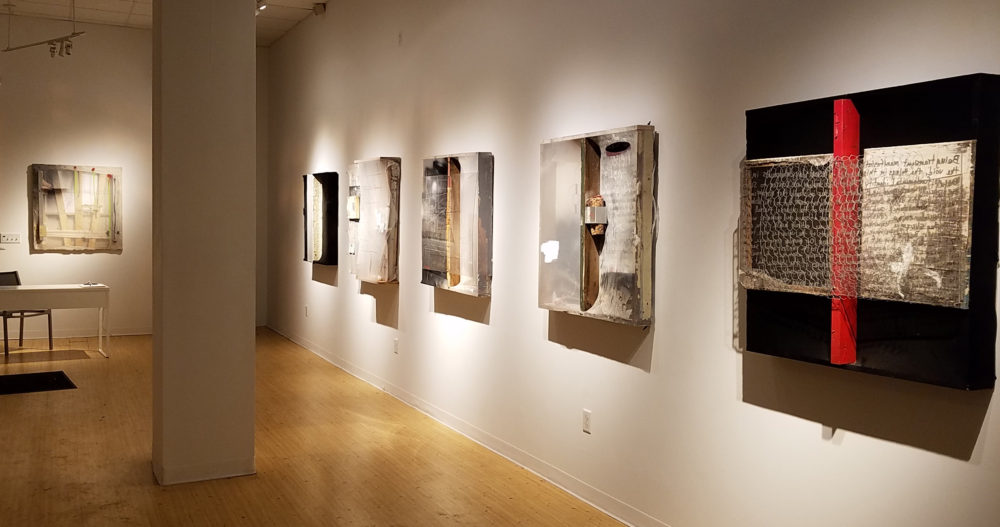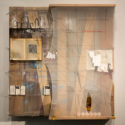A review by Gil Scullion on the very recent show of Adam Viens work.
Read below:
 Gil Scullion
Gil Scullion
April 2018
The first and most noticeable characteristic in the work of Adam Viens is its materiality. He uses all manner of salvaged, pre-owned, weathered and deteriorating materials in its construction. The EBK Gallery on Pearl Street in Hartford is exhibiting six of Viens pieces that incorporate plexiglass, transparent mesh fabric, wood products, paper, paint, pencil and ping pong balls among other materials. The visceral opulence is kept in check by a strong, formal foundation that organizes the compositions into distinct horizontals and verticals.
In a conversation with the artist we discussed the Russian Constructivist tradition of “faktura.” Following the end of the First World War progressive, Russian artists began to view their artworks as experiments. The evolutionary tendency in art was towards complete abstraction and the example of Picasso and Braque’s pre-war collages encouraged the inclusion of materials not typically employed in the production of art. The Constructivists developed a literal art that emphasized the physical properties of their media. For instance, an artist might have used glass or plastic so that elements positioned behind remained visible. Transparency was the crucial quality. A length of steel would have been used to represent rigidity and strength. Wood was easily shaped into rectangles that could be hung on a wall in the manner of paintings. The Constructivists turned these different physical properties into a language whose basis was a truth to materials. The construction of each artwork had to be clear to the viewer and each element was required to exploit its most salient characteristics. Viens suggested there were several affinities between his work and the ideas of the Constructivists. Most pronounced was a Constructivist way of learning. The process of building the pieces encouraged a kind of dialogue between the artist’s intentions and the capabilities of the materials. Viens said, “…like the Russian Constructivists, I use material as a visual language. It is visual poetry. Every material has a number of connotations, and associations that come along with it. When combined in a certain way it becomes a distillation of human experiences.” For instance, materials have what Viens termed a “degradation rate” wherein the material’s response to environmental stresses relates to “emotional or intellectual processes.”
Viens’ work goes beyond strictly formal considerations. Some of the materials he employs are already deeply embedded with ideas that are not formal in nature. For instance, he has used photographs, charts, diagrams and wooden constructions that have had a purposeful existence before they are incorporated them into an artwork. How much of their original meanings do these elements retain? In what ways do they change when they are re-contextualized?
Viens replied, “The original meanings always remain intact. Their meaning is not altered, but expanded upon. The re-contextualizing is a process of consummation bringing forth the inherent spirit already residing in the material or object. At a certain point the art object and I come to an agreement that it is done. This is sometimes after it has been killed and resuscitated many times, or sometimes after only an hour or two of deliberate choices. Either way, when it gets there, the original meanings and properties are still present, but they become dependent on the viewer. It is also the case that the more you bring to a work of art the more you are able to get out of it. Here it is especially true because some of the objects are so specifically charged that if one of the element’s original purposes is unrecognized the dialogue changes drastically. This speaks to the nature of subjectivity, when dealing with art, and any sensory experience.”
Quotations are from a correspondence between the author and Adam Viens, March – April 2018.

